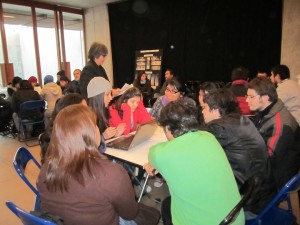Letters from Chile: A dead dictator's homage, a public history movement (Part 2)
27 June 2012 – Zachary McKiernan
human rights, international, profession, Letters from Chile, advocacy, social justice, public engagement, memory, museums, scholarship, government
/continued from Part I
At the outset of this series, I proposed two seemingly simple questions in hopes of unpacking the complexity of sites of memory and how they “engage citizens in human rights issues” vis-à-vis the past. What type of historic work is taking place? And who is doing that work? A look at these Letters offers suggestions to answer these questions but also gives shape to other critical inquiries.
What and where is the line between personal activism and professional responsibility in the struggle for human rights? How do we valorize and make visible and then useful historic sites connected to violence and terror? Why and when do public memorials—often associated with “soft culture”—move into more politically engaged and activist oriented sites of memory? Is memory a right, as some suggest? Following these threads in both a reflective and recursive way has led me to the empirical evidences as much as the intellectual exercises that shape and constantly reshape my understanding of the connection between public history and human rights—and will be covered fully in the dissertation. In short, as I rode my red bike around Santiago, I began to build practical and theoretical bridges connecting the two, seeing the relationship between the practice of (public) history and popular expressions and expectations of human rights.
Crossing these bridges, too, has also brought these Letters in close conversation with recent articles published on Public History Commons. Jeff Robinson’s smart piece on community engagement and “how art and history can catalyze and promote social change” resonates here. Art, in its many forms (mosaics, murals, music, theatre), has been instrumental in drawing attention to and engaging Chileans in human rights issues. Those critical of the mismanagement of important LGBT community archives in Chicago may take note of meticulously managed public human rights archives in Chile: Fundación de Ayuda Social de Iglesias Cristianas, Fundación Vicaria de Solaridad, Corporación de Promoción y Defensa del Pueblo, to name only a few!). Aaron Cowan’s insights on “your average public history project” has much to do with historically-oriented public projects in Chile. His question of what lessons I learned in the trenches of student human rights community engagement cannot be answered simply here. But I can say that through such engagement my own historic sensitivities and sensibilities have been sharpened by working with former political prisoners and torture survivors, community activists and historians, and a network of people committed to the historic present as much as the historic past.
About this same time last year I was taking my Ph.D. exams at UC Santa Barbara—with Chile on the September horizon. I remember a question that had to with the special contingencies of the practice of public history and human rights work—and was offered the chance to define the field according to my personal perspective. I cannot remember how completely (or how correctly) I answered this but I can remember distinctly considering the practice of public history in this context as a decidedly political act, an unequivocal stance on the part of practitioners to engage the ethical, the moral, the political, and the controversial issues and corresponding responsibilities that history and our various publics demands of us.
In Chile, this much is true. Whether it is true in other regions of the world is a personal and professional question I leave for the readers of these words. From here it is my hope that public history and public historians begin thinking seriously about our role in the struggles for human rights. And as important as it is to “establish politically minded global connection, participation, and possibility,” so too is it necessary that we walk that walk. Action and activism look good in print. But it is only through practice and pounding pavement that propels historical chance—and chances to change history.
~ Zachary McKiernan
Applying to a college, school or university will often involve you having to write an admissions essay either based on a prompt supplied or as a personal statement. This is a very important part of your application process as it is the only opportunity that you will receive to show the selection committee exactly who you are and why you should be selected over all of the other applicants.





1 comment